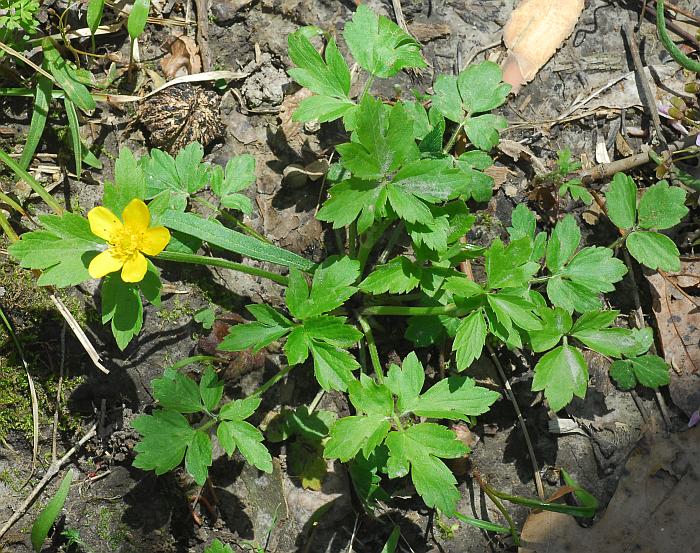Ranunculus hispidus Michx.
Bristly Buttercup

Native
CC = Amb
CW = Amb
MOC = 85
© SRTurner
Ranunculus hispidus Michx.Bristly Buttercup | |
 |
Native CC = Amb CW = Amb MOC = 85 |
© SRTurner |
|
Family - Ranunculaceae Habit - Perennial forb from fibrous to fleshy roots. Stems - Lax to ascending to erect, to 50cm, often from a spreading base, branching, sometimes rooting at lower nodes, sparsely to densely pubescent with spreading and/or appressed hairs, lacking bulbils, the base not bulbous.
Leaves - Basal and alternate, petiolate, trifoliolate. Basal leaves present at flowering, moderately to long-petiolate, the blade 2-14 cm long, 2.5-16.0 cm wide, ovate to broadly ovate or nearly heart-shaped in outline, ternately compound (the earliest leaves sometimes merely deeply lobed), the 3 primary leaflets variously unlobed or 2-5-lobed or -parted, the ultimate lobes or segments narrowly elliptic or oblanceolate to circular, the base rounded to more commonly angled or tapered, the margins otherwise few- to several-toothed toward the tip. Stem leaves with progressively shorter petioles toward the stem tip, the blade moderately to deeply 3-lobed or -divided, the segments narrowly elliptic or oblanceolate to obovate, the margins otherwise usually few- to several-toothed above the midpoint.
Inflorescence - Single pedunculate flowers from the upper leaf axils. Peduncles to 3 cm long, pubescent, angled, grooved.
Flowers - Sepals 5, 5-8 mm long, spreading or reflexed from at (then lacking a transverse fold or joint) or along a well-defined transverse fold about 1 mm above the base, plane. Petals 5, 8-16 mm long, 3-9 mm wide, obovate to oblongobovate, longer than the sepals, glossy yellow. Style present. Stamens numerous. Filaments yellow-green, glabrous, 2-3 mm long. Anthers yellow, 1.8 mm long. Receptacle pubescent.
Fruits - Head of achenes 6-12 mm long at maturity, hemispheric to ovoid or globose, the receptacle hairy. Achenes 2.2-5.2 mm long, flattened, the dorsal margin sharply angled or narrowly winged (often the entire margin angled or winged), the wall thick, smooth, glabrous, the beak 0.8-2.6 mm long, narrowly triangular, tapered, straight or somewhat curved.
Flowering - March - June. Habitat - Forests, streambanks, base of bluffs, prairies, pond margins, fens, marshes. Origin - Native to the U.S. Lookalikes - Other large-flowered species of Ranunculus, especially R. sardous and R. fascicularis. Other info. - This is a common species throughout Missouri and most of the eastern half of the continental U.S. It can be identified by its moist habitat and sprawling habit. The plant is, however, highly variable in it stem and leaf pubescence and may not always be easily recognized. The ascending stems and trifoliolate basal leaves are good characters to use for an identification. A key character to differentiate this from the similar R. sardous is the long-tapered beaks on the achenes. However, R. fascicularis achenes also have long beaks. In that species, the roots are markedly thickened and the leaves are shaped differently. Photographs taken at Eagle Bluffs Conservation Area, Boone County, MO., 4-18-04 (DETenaglia); also at Deep Ford Access, McDonald County, MO, 4-14-2013, Engelmann Woods Natural Area, Franklin County, MO, 4-20-2014, St. Francois State Park, St. Francois County, MO, 5-04-2014, and at Shaw Nature Reserve, Franklin County, MO, 4-27-2022 (SRTurner). |